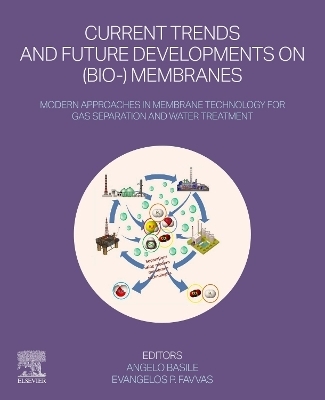
Current Trends and Future Developments on (Bio-) Membranes
Elsevier - Health Sciences Division (Verlag)
978-0-323-99311-1 (ISBN)
Finally, the book describes and discusses three novel ideas about the potential effect of the magnetic field on membrane separation efficiency, the use of cryogenic technology on membrane separations, and the use of nanobubble technology on water membrane processes.
Angelo Basile, a Chemical Engineer with a Ph.D. in Technical Physics, was a senior Researcher at the ITM-CNR as a responsible for the research related to both ultra-pure hydrogen production and CO2 capture using Pd-based Membrane Reactors. He is a reviewer for 165 int. journals, an editor/author of more than 50 scientific books and 140 chapters on international books on membrane science and technology; with various patens (7 Italian, 2 European, and 1 worldwide). He is a referee of 1more than 150 international scientific journals and a Member of the Editorial Board of more than 20 of them. Basile is also an associate editor of the: Int. J. Hydrogen Energy; Asia-Pacific Journal of Chemical Eng.; journal Frontiers in Membrane Science and Technology; and co-Editor-in-chief of the Int. J. Membrane Science & Technol. Evangelos P. Favvas is a Senior Researcher at the Institute of Nanoscience and Nanotechnology in NCSR “Demokritos, Athens - Greece. He has 80 scientific papers in peer-reviewed journals and 100 articles in international congresses; editor of 2 scientific books, 2 Greek and 4 worldwide patents. His research interests embrace the experimental study of gas separation, with emphasis on carbon dioxide and hydrogen separations, using membranes, sorbents and hybrid porous materials. The in-situ study of condensation process using the combination of X-ray and neutron scattering and adsorption techniques is another filed of his interests.
Part 1 New, promising to be commercialized, membrane
materials and units
1. Review on polymeric membrane materials for gas separations which are
stated above the Robeson’s trade-off upper bound
2. New inorganic membranes for gas separations which are stated above the
Robeson’s trade-off upper bound
3. New nonporous fillers-based hybrid membranes for gas separations and water
treatment process
4. New commercial membranes for gas separations and water desalination
processes
Part 2 New membrane manufacturing materials
5. New metal-organic frameworks and other porous filler-based hybrid
membranes for gas separation and wastewater treatment
6. Polymers of intrinsic microporosity and their applicability in pilot-scale
membrane units
7. SiC porous membranes. How possible could be the production of
high selective porous SiC membranes?
8. Carbon and graphene oxide materials and their potential applications in
membrane separation technology
9. Solvent and material selection for greener membrane manufacturing
10. New polymeric and inorganic membrane materials for water separation
Part 3 The next decade’s ideas about the future
membrane technology
11. Hybrid membranes, liquid/solid, for the enhancement of membrane gas
selectivity. The example of ionic liquid membrane
12. Cryogenic-membrane gas separation hybrid processes
13. New perspectives in gas separations (CO2/CH4, H2/CH4) using membranes
14. New perspectives in O2/N2 gas separation
15. Recent advances in the application of magnetic/electromagnetic
field for water desalination
16. Applications of graphene oxide in reverse osmosis membranes
17. Membrane water processes and nanobubble technology
| Erscheinungsdatum | 28.11.2023 |
|---|---|
| Verlagsort | Philadelphia |
| Sprache | englisch |
| Maße | 191 x 235 mm |
| Gewicht | 450 g |
| Themenwelt | Naturwissenschaften ► Chemie ► Technische Chemie |
| Technik | |
| ISBN-10 | 0-323-99311-7 / 0323993117 |
| ISBN-13 | 978-0-323-99311-1 / 9780323993111 |
| Zustand | Neuware |
| Haben Sie eine Frage zum Produkt? |
aus dem Bereich


